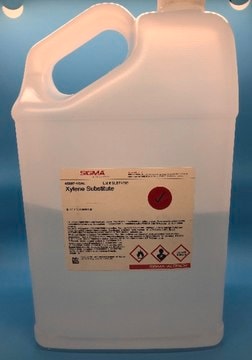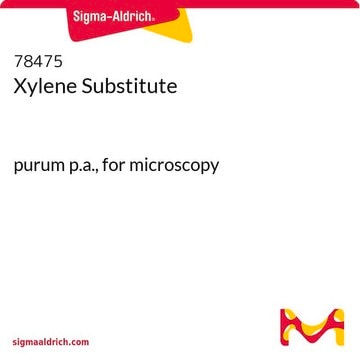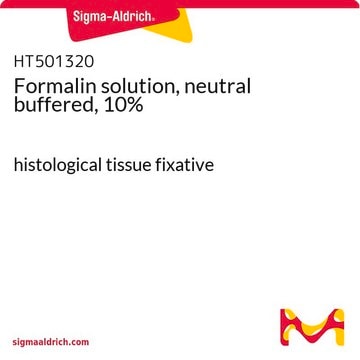Recommended Products
Application
Designed for the molecular biologist. Specially formulated to preserve antigenic sites for antibody probes and nucleic acid sites for in situ hybridizations. Fixed sections do not require predigestion or other recovery procedures to make important sites available.
Quality
Contains no formaldehyde, glutaraldehyde or mercury. Non-toxic
Legal Information
HistoChoice is a registered trademark of Amresco, Inc.
signalword
Danger
Hazard Classifications
Acute Tox. 4 Inhalation - Eye Irrit. 2 - Flam. Liq. 2 - Muta. 2 - Skin Irrit. 2 - Skin Sens. 1 - STOT SE 3
target_organs
Respiratory system
Storage Class
3 - Flammable liquids
wgk_germany
WGK 3
ppe
Eyeshields, Faceshields, Gloves, type ABEK (EN14387) respirator filter
Choose from one of the most recent versions:
Already Own This Product?
Find documentation for the products that you have recently purchased in the Document Library.
Customers Also Viewed
Michael E Titford et al.
Archives of pathology & laboratory medicine, 129(4), 502-506 (2005-03-30)
In 1987, the Formaldehyde Standard became law in the United States, alerting laboratory workers to the potential carcinogenicity of formaldehyde. As a result, a variety of proprietary fixatives were developed for use in surgical pathology. To assess histomorphology with different
M A Kacena et al.
Biotechnic & histochemistry : official publication of the Biological Stain Commission, 79(5-6), 185-190 (2005-03-15)
We compared histochemical and immunohistochemical staining as well as fluorochrome labeling in murine bone specimens that were fixed with 10% neutral buffered formalin to those fixed with HistoChoice. We showed that sections from undecalcified tibiae fixed for 4 h in
D G Vince et al.
Analytical cellular pathology : the journal of the European Society for Analytical Cellular Pathology, 15(2), 119-129 (1997-01-01)
Formaldehyde fixatives have traditionally been used to preserve tissues as they impart excellent morphological preservation. Formaldehyde fixes tissue by cross linking, a process which can reduce the antigenicity of tissue and weakens the intensity of immunohistochemical stains. Preliminary studies have
Erik P Rader et al.
Aging cell, 17(5), e12816-e12816 (2018-07-12)
Snell dwarf mice (Pit1dw/dw ) exhibit deficiencies in growth hormone, prolactin, and thyroid stimulating hormone. Besides being an experimental model of hypopituitarism, these mice are long-lived (>40% lifespan extension) and utilized as a model of slowed/delayed aging. Whether this longevity
Yan Levitsky et al.
International journal of molecular sciences, 21(11) (2020-06-03)
Mitochondrial damage in the cells comprising inner (retinal endothelial cells) and outer (retinal pigment epithelium (RPE)) blood-retinal barriers (BRB) is known to precede the initial BRB breakdown and further histopathological abnormalities in diabetic retinopathy (DR). We previously demonstrated that activation
Related Content
Three-dimensional (3D) printing of biological tissue is rapidly becoming an integral part of tissue engineering.
Our team of scientists has experience in all areas of research including Life Science, Material Science, Chemical Synthesis, Chromatography, Analytical and many others.
Contact Technical Service















